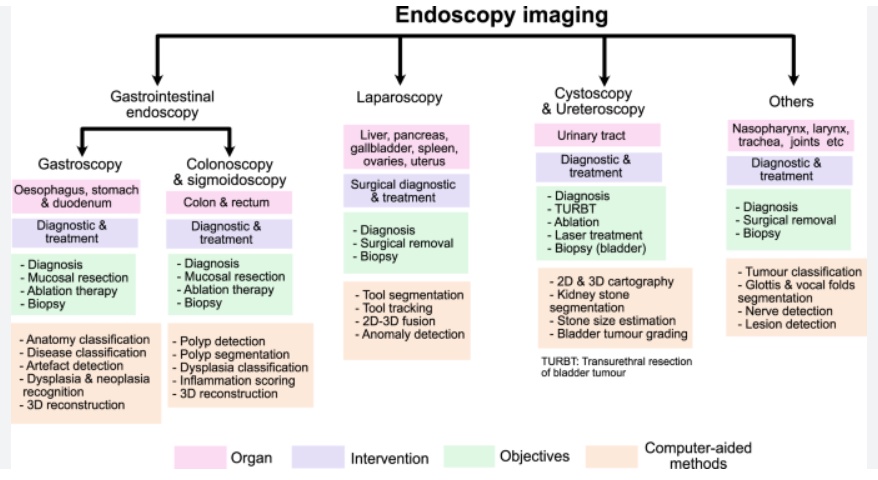Endoscopy is a medical procedure that involves examining the interior of a hollow organ or cavity of the body using an endoscope, a flexible tube with a light and camera attached.
Also, Endoscopy is not only a diagnostic tool but also serves as a therapeutic intervention for various digestive ailments. It enables the removal of abnormal tissue growths known as polyps and facilitates the placement of stents to widen narrowed passages in the esophagus or colon. Through endoscopic examination, physicians can pinpoint obstructions, inflammation, ulcers, or tumors within the digestive tract.
Moreover, it plays a crucial role in the detection of conditions like Crohn’s disease, coeliac disease, and other digestive disorders. Endoscopy is instrumental in identifying cancers affecting the esophagus, stomach, small intestine, and colon. While generally safe, it carries a slight risk of complications such as bleeding, infection, or perforation of the digestive organs.
There are several types of endoscopy, each designed to examine different parts of the body. Here are some common types of Endoscopy.
Common Types of Endoscopy
-
Upper Endoscopy (Esophagogastroduodenoscopy or EGD)
- Examines the upper digestive tract, including the esophagus, stomach, and duodenum (the first part of the small intestine).
- Used to diagnose conditions such as acid reflux, ulcers, and inflammation.
-
Colonoscopy
- Examines the large intestine (colon) and rectum.
- Used to screen for colorectal cancer, detect polyps, and investigate symptoms like abdominal pain or rectal bleeding.
-
Bronchoscopy
- Examine the airways and lungs.
- Used to diagnose lung diseases, infections, tumors, and to retrieve samples for biopsy.
-
Sigmoidoscopy
- Similar to colonoscopy but focuses on the lower part of the colon and rectum.
- Used for screening and diagnosis of conditions like colorectal cancer and inflammatory bowel disease (IBD).
-
Cystoscopy
- Examine the bladder and urethra.
- Used to diagnose conditions such as urinary tract infections, bladder cancer, and urinary blockages.
-
Laryngoscopy
- Examines the larynx (voice box) and throat.
- Used to diagnose voice or breathing problems, and to detect abnormalities like tumors or inflammation.
-
Enteroscopy
- Examine the small intestine.
- Used to diagnose conditions such as Crohn's disease, small bowel tumors, and gastrointestinal bleeding.
-
Endoscopic Retrograde Cholangiopancreatography (ERCP)
- Combines endoscopy and fluoroscopy to examine the bile ducts and pancreas.
- Used to diagnose and treat conditions such as gallstones, pancreatitis, and bile duct obstructions.
Each type of endoscopy requires specific preparation and may involve sedation or anesthesia. The choice of procedure depends on the symptoms and the area of the body that needs to be examined.
What Conditions Detected Through Endoscopy?
What diseases can be detected by an endoscopy? Endoscopy is a versatile procedure that can detect a wide range of conditions affecting various parts of the body. Some of the conditions detected through endoscopy include:
-
Gastrointestinal Disorders
- Esophageal disorders such as acid reflux, esophagitis, and Barrett's esophagus.
- Gastric conditions including ulcers, gastritis, and stomach cancer.
- Small intestine disorders like Crohn's disease, celiac disease, and small bowel tumors.
- Colorectal conditions such as colorectal cancer, polyps, inflammatory bowel disease (IBD), and diverticulosis.
-
Respiratory Disorders
- Lung diseases such as lung cancer, pulmonary fibrosis, and infections like tuberculosis or pneumonia.
- Airway conditions including bronchitis, asthma, and chronic obstructive pulmonary disease (COPD).
-
Urological Disorders
- Bladder conditions like urinary tract infections, bladder cancer, and bladder stones.
- Urethral abnormalities such as strictures or obstructions.
-
Ear, Nose, and Throat (ENT) Disorders
- Laryngeal and vocal cord abnormalities, such as nodules or polyps.
- Nasal and sinus conditions like chronic sinusitis, nasal polyps, or deviated septum.
-
Biliary and Pancreatic Disorders
- Bile duct disorders include gallstones, biliary strictures, and cholangitis.
- Pancreatic conditions such as pancreatitis, pancreatic cysts, and pancreatic cancer.
-
Cardiovascular Disorders
- Some specialized endoscopic procedures, like transesophageal echocardiography (TEE), can detect heart valve abnormalities, blood clots, or infections in the heart.
These are just some examples, and the scope of conditions detectable through endoscopy continues to expand as technology advances and techniques become more sophisticated. Always consult with a healthcare professional for an accurate diagnosis and appropriate treatment plan.
Is Endoscopy Safe?
Endoscopy is considered a safe medical procedure when performed by experienced professionals using an endoscopy management system in a perfect setting. While there are potential risks, such as bleeding, infection, or perforation, they are relatively rare. Patient safety is prioritized through careful patient selection, thorough preparation, and the use of sedation or anesthesia when necessary.
The expertise of the healthcare team and adherence to facility standards further contribute to ensuring the safety of endoscopic procedures. Patients should communicate any concerns to their healthcare provider and follow pre- and post-procedure guidelines to minimize risks and ensure a smooth and successful experience.
End Speach
Understanding the various types of endoscopy and their role in diagnosing and treating digestive diseases is crucial for patients and healthcare professionals alike, facilitating early detection, effective management, and improved outcomes.


No comments yet